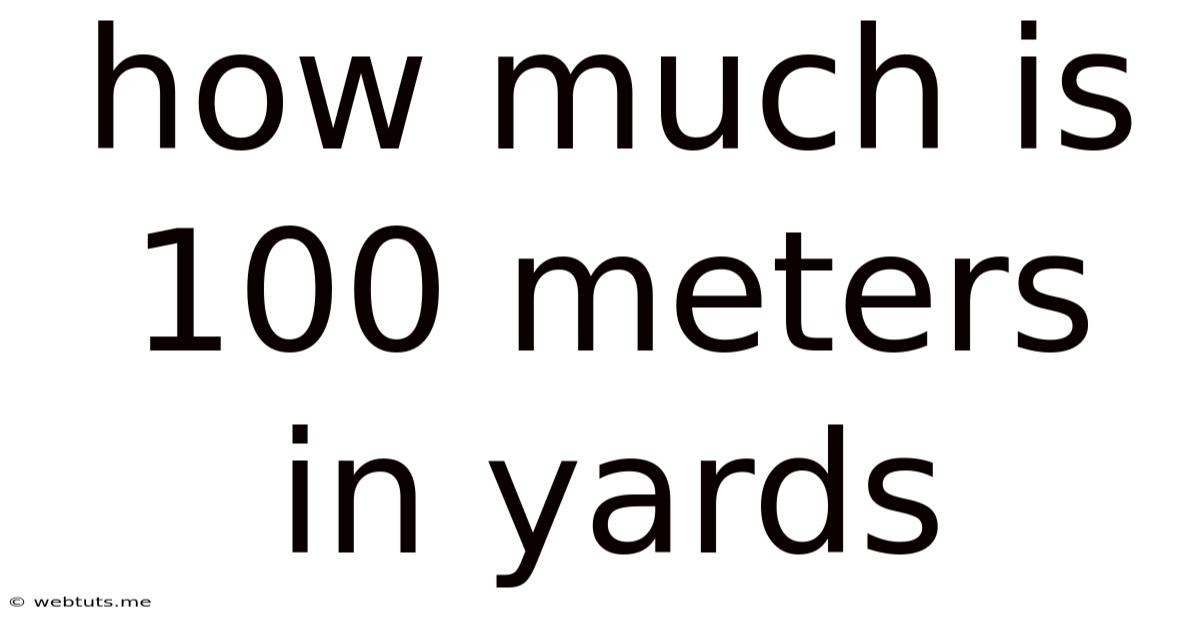How Much Is 100 Meters In Yards
Webtuts
May 10, 2025 · 4 min read

Table of Contents
How Much is 100 Meters in Yards? A Comprehensive Guide to Metric-Imperial Conversions
Knowing how to convert between metric and imperial units is a crucial skill, especially in a globalized world where different systems of measurement coexist. This comprehensive guide delves deep into the conversion of 100 meters to yards, providing not only the answer but also the underlying principles, practical applications, and helpful tips for future conversions.
Understanding the Units: Meters and Yards
Before diving into the conversion, let's understand the units involved:
Meters (m): The meter is the fundamental unit of length in the International System of Units (SI), the modern form of the metric system. It's a widely used unit globally for measuring distances, heights, and lengths.
Yards (yd): The yard is a unit of length in the imperial and US customary systems of measurement. It's commonly used in several countries, particularly for measuring fabrics, land, and some sporting events.
The Conversion Factor: Bridging the Gap
The key to converting between meters and yards lies in the conversion factor. One yard is equal to approximately 0.9144 meters. This means that a yard is slightly shorter than a meter. We'll use this conversion factor throughout our calculations.
Calculating 100 Meters in Yards
To convert 100 meters to yards, we can use the following formula:
Yards = Meters / 0.9144
Plugging in the value:
Yards = 100 meters / 0.9144 meters/yard ≈ 109.36 yards
Therefore, 100 meters is approximately equal to 109.36 yards.
Practical Applications: Where This Conversion Matters
Understanding the conversion between meters and yards has numerous practical applications across various fields:
1. Sports and Athletics:
- Track and Field: Many international track and field events use metric measurements (e.g., 100-meter dash), while some local or historical events might use yards. Knowing the conversion helps compare performances across different systems.
- Football (Soccer): The dimensions of a football field can be expressed in both meters and yards, making conversion essential for understanding field sizes in different contexts.
- American Football: While primarily using yards, understanding metric equivalents is useful for international comparisons and collaborations.
2. Construction and Engineering:
- Blueprint Conversions: Construction blueprints might use either metric or imperial units depending on the region and project. Conversion is crucial for seamless project execution.
- Material Ordering: Ordering materials like lumber or fabrics requires accurate unit conversions to ensure the right amount is ordered.
- Land Surveying: Converting land measurements between metric and imperial systems is vital for accurate land records and property transactions.
3. Textile and Apparel Industries:
- Fabric Measurements: The apparel industry uses both systems for measuring fabric lengths and garment dimensions. Conversion is critical for accurate pattern making and production.
- International Trade: Global trade requires accurate conversions for consistent communication and preventing misunderstandings.
4. Travel and Navigation:
- Distance Calculations: Converting distances between metric and imperial units is essential for planning trips, understanding road signs, and using GPS devices effectively in various countries.
- Map Interpretation: Maps often use different units, requiring conversions for accurate navigation.
Beyond the Basic Conversion: Exploring More Complex Scenarios
While converting 100 meters to yards is straightforward, more complex scenarios might arise:
- Converting from yards to meters: The formula simply reverses: Meters = Yards * 0.9144
- Converting larger distances: For distances significantly larger than 100 meters, the same principle applies, simply multiplying the number of meters by the conversion factor.
- Converting areas and volumes: Converting areas (square meters to square yards) or volumes (cubic meters to cubic yards) requires squaring or cubing the linear conversion factor, respectively.
Tips for Accurate Conversions
- Use a calculator: For precise results, especially with larger numbers, use a calculator or online converter.
- Round appropriately: For practical purposes, rounding to a reasonable number of decimal places (e.g., two decimal places for yards) is often sufficient.
- Double-check your work: Always double-check your calculations to avoid errors.
- Understand the context: The level of precision required depends on the application. A rough estimate might suffice for some purposes, while high accuracy is crucial for others.
Mastering Metric-Imperial Conversions: A Valuable Skill
The ability to convert between metric and imperial units is a highly valuable skill in today's interconnected world. Whether you're involved in international trade, engineering projects, athletic competitions, or simply navigating a diverse environment, understanding these conversions empowers you to communicate effectively, work accurately, and overcome potential measurement challenges. By grasping the fundamental principles and employing the techniques outlined in this guide, you'll be well-equipped to handle any metric-imperial conversion task with confidence and precision. Remember to practice regularly to solidify your understanding and refine your skills. This will prove to be an invaluable asset in various aspects of your personal and professional life. The ability to effortlessly switch between units ensures clarity and avoids costly mistakes or miscommunication.
Latest Posts
Latest Posts
-
What Year Was 62 Years Ago
May 10, 2025
-
How Many Teaspoons In One Oz
May 10, 2025
-
How Many Pounds Is In 32 Ounces
May 10, 2025
-
How Many Days Ago Was October 26
May 10, 2025
-
How Many Days Until July 27th 2024
May 10, 2025
Related Post
Thank you for visiting our website which covers about How Much Is 100 Meters In Yards . We hope the information provided has been useful to you. Feel free to contact us if you have any questions or need further assistance. See you next time and don't miss to bookmark.